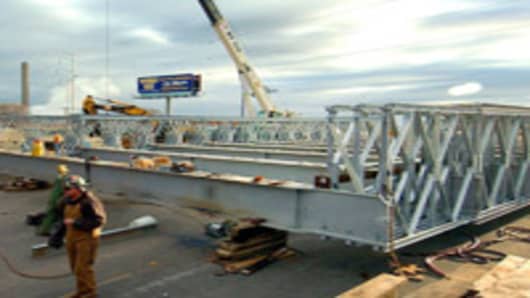These days almost everyone seems to agree that we need to spend more on infrastructure. But there’s really not much evidence for this idea.
Over the weekend, for example,Robert Frank attempted to make the case for increased government infrastructure spending as a way to stimulate the economy. But the arguments he marshals are surprisingly weak.
All the while, however, we’re facing vivid examples of failing infrastructure across the country. Clearly, the maintenance and rebuilding of bridges, roads, water systems and the like can’t be postponed forever. And the work will never be cheaper to accomplish than right now, when high unemployment and excess capacity have put the opportunity cost of the necessary labor and equipment near zero.
In short, circumstances cry out for an immediate rebuilding effort.
President Obama’s proposal last week to create a $50 billion infrastructure renewal bank is thus a small but welcome first step.
Europe spends about 5 percent of its annual gross domestic product on infrastructure, while China spends about 9 percent, according to the “Report Card for America’s Infrastructure” by the American Society of Civil Engineers. In the United States, which spends less than 2.5 percent, chronically deferred maintenance has left the infrastructure in dangerously substandard condition.
More than 25 percent of the nation’s bridges, for example, were structurally deficient or obsolete in 2007, according to the Federal Highway Administration.
Let’s address each of these points briefly.
Opportunity Costs:Frank’s just wrong here. The opportunity costs of using unemployed labor are not zero. The years spent building government roads and bridges are years in which the laborers are not learning marketable skills or moving to areas with better employment prospects. That is a serious opportunity cost.
One of the reasons unemployment has been so persistent is that the housing boom misdirected so many people into the construction industry, where they spent years acquiring skills the economy did not really need. Continuing this cycle of malinvestment of human capital is unfair to the workers and economically stupid.
China Spends 9% Of Its GPD On Infrastructure:In the first place, China is involved in its early stage build out of its national infrastructure. Of course this is far more costly than the maintenance costs faced by the U.S. What’s more, China’s infrastructure program has all the markings of a make-work program—building roads and entire cities to nowhere in order to mask serious underlying problems with its economy.
We Have Chronically Deferred Maintenance Of Our Infrastructure: This is probably the most common argument for infrastructure spending. The flaw in the argument is that it assumes that it is rational to maintain 100% of our current infrastructure.
Let’s assume that Frank is correct that 25% of our bridges are obsolete or structurally deficient. This indicates that the bridges should either be closed or repaired soon. The question of whether they should be closed or repaired, however, cannot really be answered because of the government’s involvement in these projects.
A private firm would make entrepreneurial guesses about whether further investment would earn a high enough return to be justified.
The government makes these decisions politically and bureaucratically—which means it simply has no economic criteria for deciding which bridges should be maintained or closed. That's why we get projects like the famous bridge to nowhere.
In short, it’s possible that we should be spending more on infrastructure—but there’s no way to tell because of the pervasive government role in the sector.



